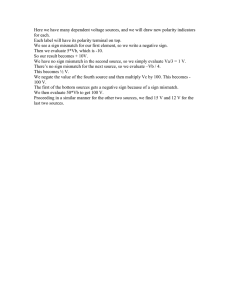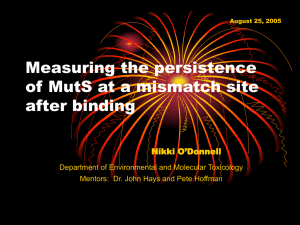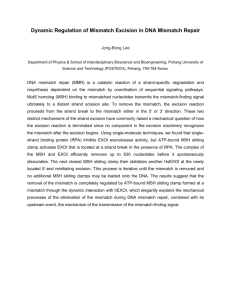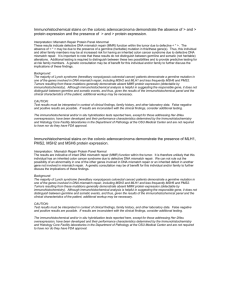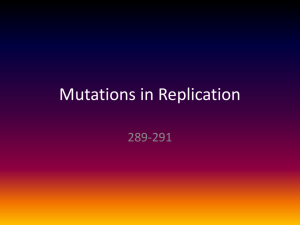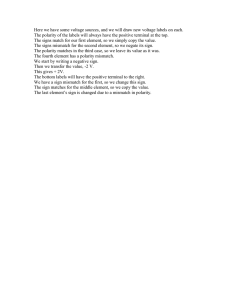High Throughput Genome Sequencing: A Test of Functional Overlap in Mismatch Repair Proteins
advertisement
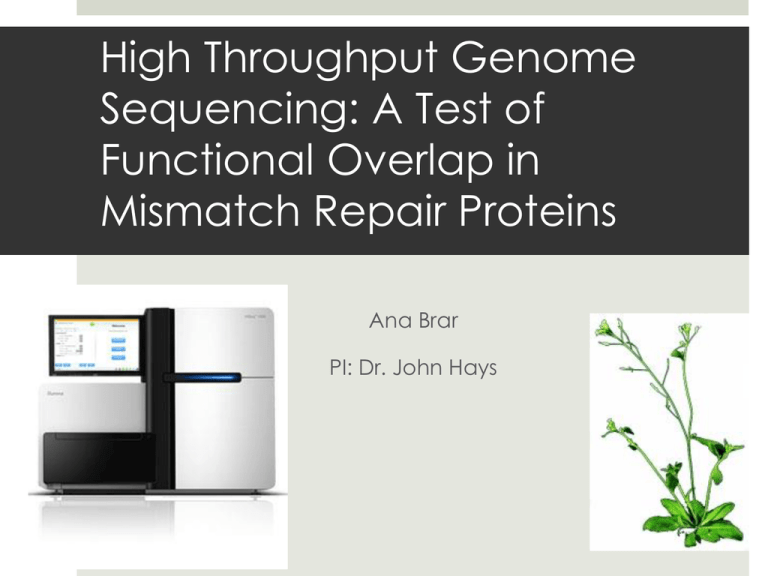
High Throughput Genome Sequencing: A Test of Functional Overlap in Mismatch Repair Proteins Ana Brar PI: Dr. John Hays Background Endogenous and exogenous sources of mutation challenge fidelity of DNA DNA damage response (DDR) systems minimize accumulation of mutations Mismatch repair Mismatch Repair (MMR) Highly conserved Post-DNA replication Triggered by the mismatch of noncomplementary base pairs and short insertion/deletion loop-outs Recognize pre-mutagenic DNA lesions, recruit necessary proteins, remove the nascent DNA strand, and subsequently resynthesize through the resulting gap MMR Pathway Mismatch recognition G T Strand choice G T Excision Resynthesis • MutS family * • MutL family T • PCNA • RPA • Exonucleases A T • Replicative DNA polymerase MMR Heterodimers MSH MSH 2 6 MutS α MSH MSH 2 3 MutSβ MSH MSH 2 7 MutSγ Arabidopsis thaliana: A Model System Small genome (250 Mb) Genome sequenced Short life cycle (6 weeks) Extensive collection of mutants available Thousands of progeny Plant mismatch repair pathway is similar to animal mismatch repair Hypothesis AtMSH6 and AtMSH7 are non-redundant and are responsible for the correction of different mismatches Prediction 1 If MSH2/MSH6 and MSH2/MSH7 are responsible for correction of different mismatches, then plants deficient in these protein activities that are propagated generation to generation will accumulate different spectra of mutations as analyzed by genome resequencing Prediction 2 If MSH6 and MSH7 activities are redundant then a MSH6/MSH7 double mutant will display a more pronounced phenotype than either single knock-out when propagated generation to generation Experimental Set-up Experimental Set-up Experimental Set-up Experimental Set-up Methods Mutation Accumulation (MA) line propagation for five generations Illumina high throughput sequencing MSH6-/ MSH7-/ MSH6-/-/MSH7-/- Programs BWA and CASHX to parse, map, align, and identify mutations Methods To assess MSH6/MSH7 redundancy, existing MSH6-/- and MSH7-/- lines have been crossed and 18 independent lines propagated generation to generation while scoring phenotypes: Germination frequencies Vegetative growth Seed set Mutation rate and spectrum Results - pending Significance At the cutting edge of bioinformatics technology An increasingly affordable and prompt technique In vivo information about what lesions various mismatch repair proteins are responsible for correcting This data will complement and verify in vitro biochemical DNA lesion binding studies Defective mismatch repair machinery has been associated with an increased risk of certain cancers (i.e. Human non-polyposis colorectal cancer) Strengthen the utility of Arabidopsis thaliana as a model for the study of mismatch repair and DDR Acknowledgements The Howard Hughes Medical Institute Cripps Research Scholarship Dr. John Hays Buck Wilcox Dr. Marc Curtis Peter Hoffman Dr. Kevin Ahern
